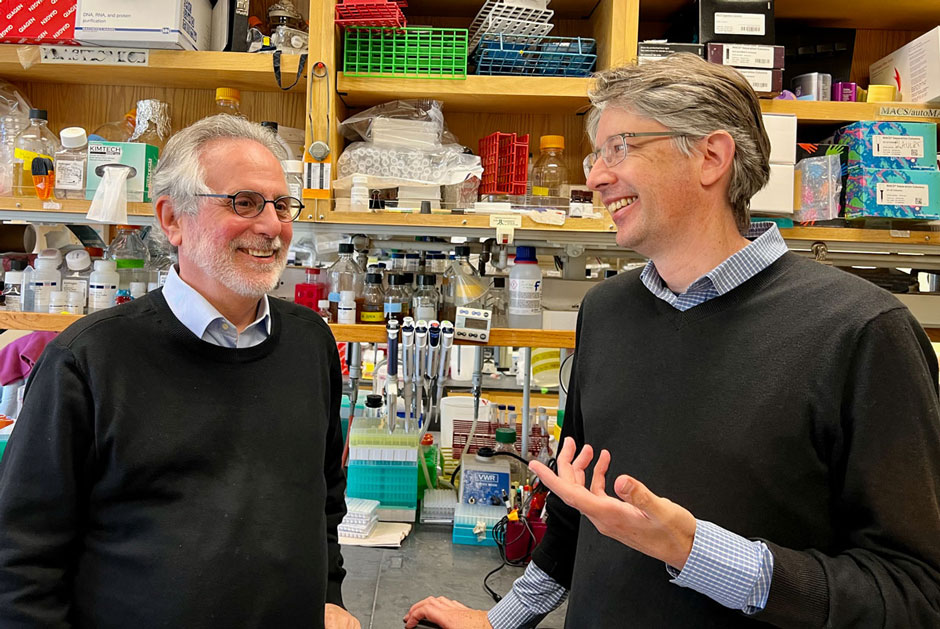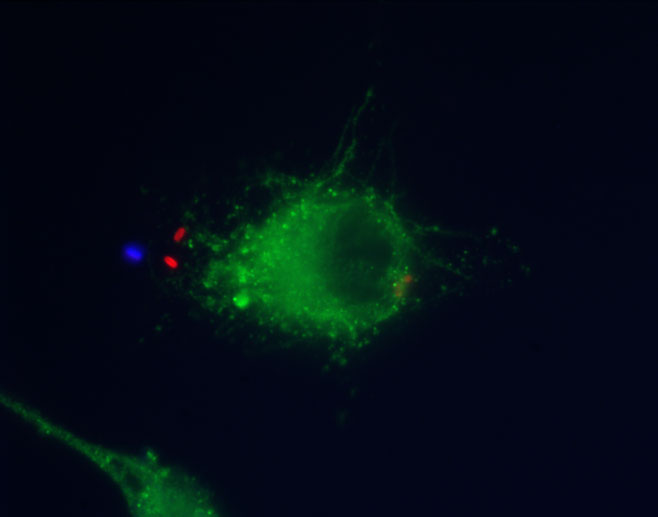A Winding Path
The long, twisty route from bench to breakthrough
By Kirsten Mickelwait

“It's the typical circuitous route of science,” says immunologist and MCB professor David Raulet of his collaboration with Russell Vance, an MCB professor and HHMI Investigator. He’s describing the way scientific discoveries are usually made, which is anything but linear. The two researchers, who have been working together off and on for more than 25 years, currently study interferons — a type of protein that normally helps trigger the immune response to viruses. Both labs explore how the immune system’s production of interferons can also improve the treatment of cancers.
The collaboration began in 1995 when Vance was a graduate student in Raulet’s lab. He left in 2000 to do postdoctoral work at Harvard, returning to Berkeley in 2006 to start his own lab. During that period, he had begun to focus on pathogens while Raulet turned his attention to tumors.
Both scientists were interested in the innate immune system, but were studying different aspects of it. Raulet’s lab was doing work with natural killer (NK) cells, a type of killer lymphocyte, seeking to understand how they worked and how they could destroy tumor cells.
Meanwhile, Vance’s lab was investigating an immune response that requires a protein in our bodies called STING (stimulator of interferon gene). While STING had already been identified, how it was activated was a mystery. The Vance Lab made the important discovery that it is activated by small molecules called cyclic dinucleotides, triggering a series of events in the cell that create an immune response that kills pathogens.
“My lab primarily studies the immune response to infection, not cancer,” says Vance. “However, the immune pathways that are stimulated by infectious microbes can also be exploited in cancer therapy. And David’s lab has shown that stimulation of anti-viral pathways results in robust anti-tumor immunity.”
It was one of Raulet’s postdocs, Assaf Marcus, who first saw a connection between the labs’ parallel work. Marcus spearheaded a collaboration that applied the STING response on infectious disease to cancer tumors. The new work showed that the immune pathways that detect and respond to infections are often the same ones that are used to detect tumors and mobilize NK cells to attack them. Together, the two labs began working on the question of how tumors were being detected, which led to their first paper on the subject in the journal Immunity in 2018.

The partnership continued, building upon this earlier work to take the research to the next level: using the STING pathway as an immunotherapy tool. When STING is activated, cells secrete proteins called interferons, whose main function is to activate cells of the immune system to “interfere” with virus replication — often by having the immune cells kill the virus-infected cells. The labs’ shared research discovered that interferons are also able to activate cells of the immune system to kill tumor cells.
“The natural immune response against cancer is rather weak and tumors often overcome it or evade it,” Raulet says. “Evasion of the T cell response is a big problem in immunotherapy, and we know that one of the evasion mechanisms that tumors use actually makes the tumor cells more sensitive to being killed by NK cells.” His lab’s recent work, led by former graduate student Chris Nicolai and current graduate student Natalie Wolf, shows that combining STING activation with injections of proteins that stimulate NK cells can lead to extremely strong anti-tumor effects mediated by NK cells and T cells — more effective than other combination pairs that have been reported for difficult-to-treat models of cancer in mice. A 2020 paper on that work was published in Science Immunology.
For his work with STING, Vance received the 2020 William B. Coley Award for Distinguished Research in Basic and Tumor Immunology from the Cancer Research Institute — the top award worldwide for cancer immunology. Raulet received the same award in 2002 for his work in understanding NK cell recognition and recognizing its potential for cancer therapy.
Recent work by the Vance Lab has led to the discovery of new ways to stimulate interferon production. Postdoc Moritz Gaidt became interested in how the herpes simplex virus (HSV) is detected by the immune system and found that a human protein called MORC3 is critical for the detection of HSV. Once MORC3 detects HSV, the immune system responds by producing interferons. “The effects of activating the MORC3 pathway are similar to the effects of activating the STING pathway,” Vance says. “We believe that it might also be possible to stimulate the MORC3 pathway as an anti-tumor therapy.”
Both Raulet and Vance credit UC Berkeley and MCB as environments in which such creative collaboration is encouraged. “One of the great things about an institution that favors basic, or mechanistic, science: it's about understanding the basic mechanisms of cellular processing,” Raulet says. “I think that's where that's where great discoveries occur, which can lead to the next big breakthroughs.”
Vance agrees. “These new discoveries and original therapies almost always come from basic science,” he says. “MCB really values curiosity-driven research. We’re encouraged to follow these weird blind alleys. That’s how real science works. You start off trying to do one thing, you end up doing another thing, or you have a collaboration with somebody that goes in this other direction that you didn't expect. There's always a kind of winding path.”
Learn more about the research in the Raulet Lab and Vance Lab
Banner photo credit: Human Natural Killer by National Institutes of Allergy and Infectious Diseases (NIAID)
Back to Main Fall 2021 Newsletter Page
| Connect With Us! | ||||
MCB Twitter |
 MCB Facebook |
 LinkedIn Postdocs, PhDs, or Undergrads |
 Cal Alumni Network |
 Give to MCB |

